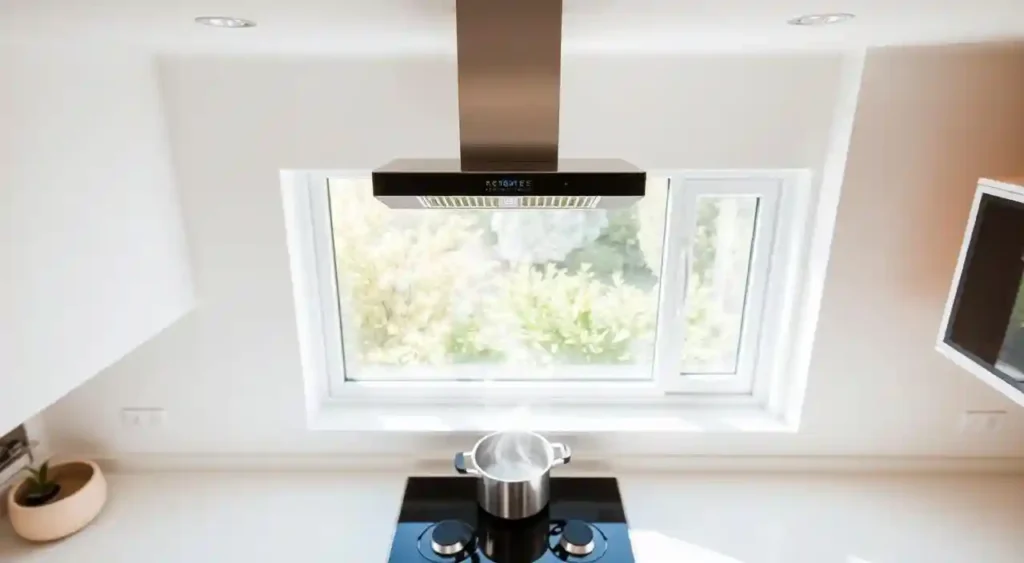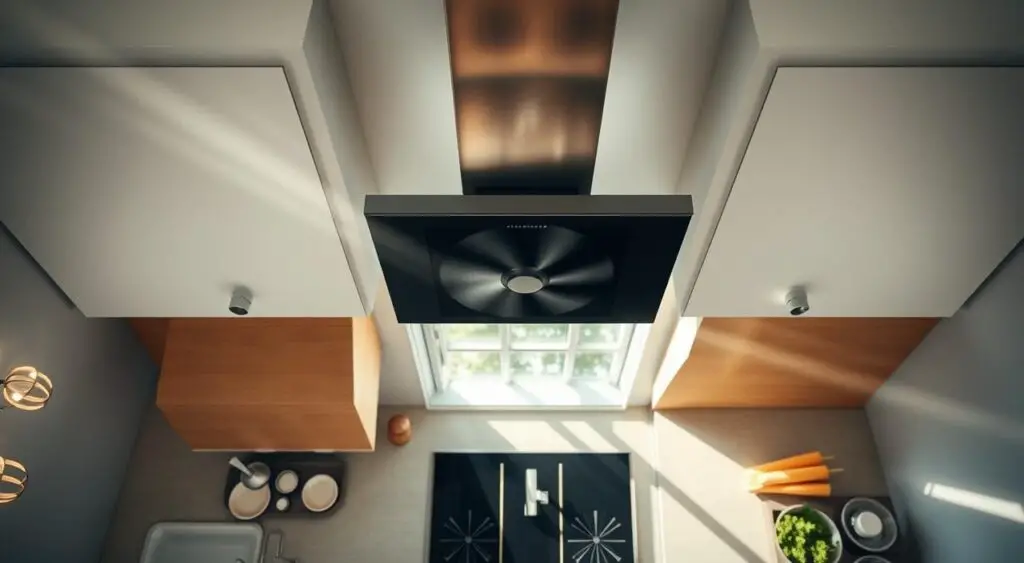Do You Need An Extractor Fan In A Kitchen With A Window?
Updated: 28 August 2024
34
Do You Need An Extractor Fan In A Kitchen With A Window?
Many homeowners ask if they need an extractor fan in a kitchen with a window. Both options have their benefits and serve different purposes. A window can let in some air, but an extractor fan is better at removing cooking smells and pollutants.
Whether you should get an extractor fan depends on your kitchen’s size, how often you cook, and local building codes. We’ll look at why an extractor fan is good for kitchens with windows. We’ll also talk about what to think about when picking the right ventilation for your kitchen.
You can also read:
Top Ideas For White Kitchen Cabinets with Black Hardware:
Key Takeaways
- A window can provide some natural ventilation, but an extractor fan is often recommended to effectively remove cooking odors, steam, and pollutants.
- The choice between a window and an extractor fan depends on factors such as kitchen size, cooking frequency, and local building code requirements.
- Extractor fans can significantly improve indoor air quality by removing cooking-related contaminants and odors.
- Noise level and airflow capacity are key considerations when selecting an appropriate extractor fan for your kitchen.
- Regular maintenance and cleaning of the extractor fan are essential for ensuring its optimal performance and longevity.
The Benefits of an Extractor Fan in a Kitchen with a Window
Installing an extractor fan in a kitchen with a window brings many benefits. It improves air quality and odor removal. These fans are key to keeping the cooking area comfortable and healthy.
Improved Air Quality
Extractor fans are great at removing cooking fumes, smoke, and indoor air pollutants. A study showed that over half of California homes with gas stoves had high pollutant levels. An extractor fan filters and removes these pollutants, making the kitchen cleaner and healthier.
Odor Removal
Extractor fans are also better at getting rid of cooking smells than just using a kitchen window. They can take away the smell of sautéed garlic or a simmering stew. This leaves the kitchen smelling fresh and welcoming.
By choosing a good extractor fan, homeowners get a healthier kitchen, even with a window. These fans boost indoor air quality. They make cooking more enjoyable and can even increase property value when selling the home.
Do you need an extractor fan in a kitchen with a window?
Many think a kitchen window means you don’t need an extractor fan. But, experts say an extractor fan is key for good air and smell control, even with a window.
A kitchen window helps with airflow, but an extractor fan is better at removing cooking smells and smoke. It pulls out these particles actively, not just by natural airflow.
Some building codes say you must have an extractor fan in the kitchen, window or not. This is especially true for busy kitchens or homes where cooking is a big part of life. Good ventilation is essential for safety and air quality.

Choosing between a window or an extractor fan depends on your kitchen’s needs. If you cook a lot or worry about air quality, an extractor fan is a must, even with a window.
Factors to Consider When Choosing a Kitchen Extractor Fan
When picking a kitchen extractor fan, think about noise level and airflow capacity. It’s important to find a fan that is quiet, especially if your kitchen is near living spaces. The fan should also have enough airflow to clear out cooking smells and pollutants, depending on your kitchen’s size and layout.
Noise Level
A loud kitchen extractor fan can disrupt your daily life, making it hard to talk or listen to music. Thanks to new technology, there are now silent extractor fans that remove moisture and smells quietly. Envirovent offers quiet models like the Silent 125 and Silent 150.
Airflow Capacity

The size of your kitchen affects how much airflow your extractor fan needs. For cooking two or three items, you should look for a fan with at least 400m³ per hour airflow. Fans with more than 650m³ per hour often come with timers because of energy-saving rules.
Good ventilation in kitchens is key for clean air and preventing damp. Don’t just focus on the fan’s quietness; consider how well it removes moisture and smells too. Finding the right balance between noise and airflow is crucial for a good kitchen extractor fan.
Types of Kitchen Extractor Fans
There are two main types of extractor fans for kitchens: wall-mounted and ceiling-mounted. Each type has its own benefits to improve air quality and comfort while cooking.
Wall-Mounted Extractor Fans

Wall-mounted extractor fans sit above the cooktop or hob. They capture and remove cooking fumes, smoke, and odors right at the source. These fans are easy to reach for adjustments and upkeep. Ceiling-Mounted Extractor Fans
Ceiling-mounted extractor fans are placed above the cooking area. They’re great for kitchens with little wall space or specific layouts. These fans are perfect for kitchen renovations aiming for a sleek, integrated look.
Wall-mounted extractor fans and ceiling-mounted extractor fans both work well at removing pollutants and enhancing air quality. Choosing between them depends on space, accessibility, and how they fit with your kitchen’s style.
| Feature | Wall-Mounted Extractor Fans | Ceiling-Mounted Extractor Fans |
|---|---|---|
| Placement | Above the cooktop or hob | Directly above the cooking area |
| Accessibility | Easily within reach for adjustments and maintenance | It can be more visually prominent |
| Aesthetic Integration | Can be more visually prominent | Offer a more streamlined, integrated look |
| Suitability for Kitchen Renovations | Versatile and can be incorporated into various kitchen designs | Ideal for kitchens with limited wall space or specific design requirements |
Installing a Kitchen Extractor Fan

Putting in a kitchen extractor fan is easy but might need a skilled electrician or HVAC pro. You’ll need to cut a hole in the wall or ceiling, set up ductwork outside, and link the fan to the power. It’s key to follow building codes and safety rules for energy efficiency and good airflow.
A 60L/S extractor fan should go in kitchens away from the stove, says building control. Also, keep extractors at least 150mm from windows to prevent problems. Many are now using recirculating fans with separate ventilation systems for better airflow without losing heat.
- Find the best spot for the extractor fan, thinking about how close it is to the stove and windows.
- Work with a pro to make sure the setup meets building code rules and safety levels.
- Get the area ready by cutting holes in the wall or ceiling.
- Put in the ductwork outside, making sure it flows well and saves energy.
- Connect the extractor fan to the power system, following safety steps.
- Check the extractor fan to make sure it works right and vents well.
In the UK, building regulations say you must keep or replace kitchen ventilation systems, like extractor fans, during kitchen renovations. Listed buildings might get exceptions to keep their historic look. But, new buildings, kitchen extensions, and makeovers must have some kitchen ventilation.
Extractor Fan Maintenance and Cleaning
Keeping your kitchen extractor fan clean is key for its efficiency and energy use. Regular cleaning makes sure it works well and lasts longer. It’s important to clean the filters, blades, and housing regularly.
To clean your kitchen extractor fan, you’ll need some tools. These include hot water, rubber gloves, microfiber towels, cleaning brushes, dish soap, baking soda, and white vinegar. First, unplug the fan and take out the mesh filters to soak them in hot soapy water.
Then, clean the fan blades and housing with a brush to get rid of grease or dirt. If the fan has a stainless steel part, use a special cleaner for it. Let everything dry before putting the fan back together.
Bathroom extractor fans don’t have filters but still need cleaning to work right. Take apart the fan into parts like the vent cover, blades, and housing. Clean each part with warm water and dish soap.
Let everything dry before putting the fan back together. This way, you’ll have fresh, odor-free air. Regular maintenance keeps your kitchen and bathroom renovations efficient and well-ventilated.
FAQ
Do you need an extractor fan in a kitchen with a window?
Even with a window, an extractor fan is often a good idea. It helps remove cooking smells, steam, and pollutants. Think about the noise, airflow, and building codes when deciding.
What are the benefits of an extractor fan in a kitchen with a window?
An extractor fan boosts kitchen air quality by taking away cooking fumes, smoke, and pollutants. It’s better at getting rid of cooking smells than just a window.
Is an extractor fan necessary in a kitchen with a window?
A window helps with ventilation, but an extractor fan is usually a better choice. It’s more effective at removing cooking smells and pollutants. Sometimes, building codes require an extractor fan, even with a window.
What factors should be considered when choosing a kitchen extractor fan?
Look at the noise level and airflow capacity when picking a kitchen extractor fan. Choose one that’s quiet and has enough airflow for your kitchen size and layout.
What are the different types of kitchen extractor fans?
There are wall-mounted and ceiling-mounted kitchen extractor fans. Wall-mounted fans go above the cooktop, and ceiling-mounted fans are above the cooking area. Both types work well, but the best one depends on your kitchen’s design.
How do you install a kitchen extractor fan?
Installing a kitchen extractor fan is usually easy but might need a pro. It could mean cutting a hole, running ductwork, and connecting it to the electrical system. Make sure it’s installed right to follow building codes and keep it safe.
How do you maintain and clean a kitchen extractor fan?
Keeping your kitchen extractor fan clean and maintained is key. Clean or replace the filters, wipe the fan blades and housing, and check the ducts for blockages. Doing this keeps the fan working well and the air clean.
Please Write Your Comments